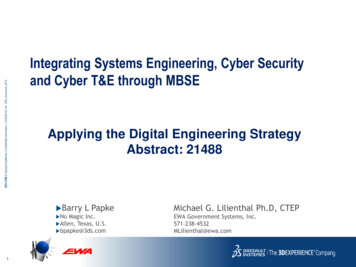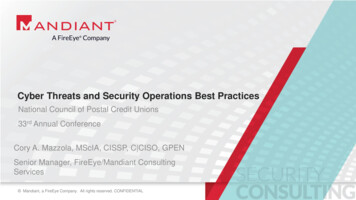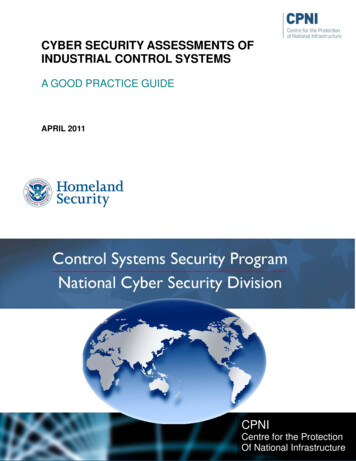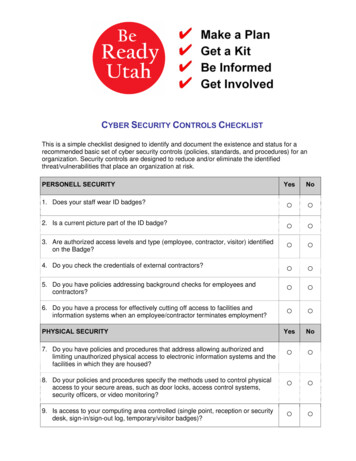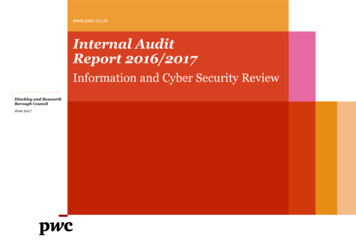
Transcription
www.pwc.co.ukInternal AuditReport 2016/2017Information and Cyber Security ReviewHinckley and BosworthBorough CouncilJune 2017
BackContentsExecutive summary1Findings2AppendicesA. Basis of our classifications2B. Terms of referenceDistribution listFor action:Michael Dungey, ICT ManagerJulie Kenny, Monitoring OfficerFor information:Audit CommitteeInternal Audit Report 2016/17PwC2
Executive summaryCurrent year findingsAppendicesExecutive summary (1 of 4)Report classificationTotal number of findingsHigh riskCritical(21 points)TotalInternal Audit Report 2016/17PwC-High1Medium3Low2Advisory-3
Executive summaryCurrent year findingsAppendicesExecutive summary (2 of 4)Headlines/summary of findingsThis review looked at Hinckley & Bosworth Borough Council’s (HBBC) current cyber security 'as is' position by performing a gap analysis ofinformation and cyber security risks in six areas; priorities, risk, connection, people, technology and response. The detailed scope of our work isincluded in our terms of reference in Appendix B. HBBC are operating a commercial IT model whereby they are providing IT services to a numberof other local Councils. Our review is only looking at HBBC infrastructure and applications.The outcome of our review has noted one high, three medium and two low risks: Security Monitoring (high risk): An absence of security monitoring tools to detect and alert on suspicious activity on the network; Access Control (medium risk): There is a lack of a centralised IT system to manage user access across different applications at HBBC. Theleavers process is also disjointed due to the correct individuals/departments not all receiving notifications of movers and leavers; Third Party and Physical Access (medium risk): Right to audit clauses are included in supplier contracts but are not performed toensure suppliers are complying with security clauses and delivering service as expected. Absence of security monitoring (e.g. CCTV) in the datacentre, which would hinder an investigation if an incident was occurred due to malicious activity; Incident Response Procedure/Plan (medium risk): The current incident response procedure does not cover all steps required to befollowed in an event of a security incident occurring. Some important information is missing from the process document, for example thecontact details of internal and external contacts to notify of incidents and actions that need to be taken for security related incidents; Information Training and Awareness (low risk): Users that have privileged access or may handle sensitive data are not provided withtargeted training to raise awareness of the potential security risks and challenges associated with their job role and level of users access; and Information Security Policy, classification and asset register (low risk): There is no information security policy to outline highlevel objectives in regards to the measures and governance of information security. A number of policies assessed as part of the audit are notreviewed on an annual basis and do not have version control for completeness. Currently there is no information classification in place todetect and restrict sensitive and personal information leaving the network and no data loss prevention (DLP) tool is implemented. Across theorganisation there an absence of a comprehensive information asset register to outline the information assets at HBBC and the risksassociated.We would like to thank the staff involved in this review for their help during this internal audit.Internal Audit Report 2016/17PwC4
Executive summaryCurrent year findingsAppendicesExecutive summary (3 of 4)Management commentsThe Authority is already aware of the issues noted in relation to SIEM software and have already secured software that will cover the SIEMissue called Manage Engine ADAudit, to be deployed as part of the agreed work programme for Steria 2017/18. In the meantime, we havefirewall and other security procedures in place to reduce the risk of unauthorised access. Therefore as action is being taken we do not feel thehigh risk rating is warranted as the risk is being addressed, and we have unauthorised access prevention software in place. We are unaware ofwide spread use of SIEM software in councils, so feel we are making progress by our proactive action to include procurement of SIEM solutionsoftware in the near future. We accept it was not in place at the time of the audit, but feel our current set up was reasonable.Internal Audit Report 2016/17PwC5
Executive summaryCurrent year findingsAppendicesExecutive summary (4 of 4)Good practice12There are a number of user awareness and training initiatives in place such as e-learn modules,annual data protection refresher courses and information governance display posters.Role based background checks are conducted on employees.3A mobile device management (MDM) solution is in place to manage corporate mobile devices acrossthe organisation.4A number of data security policies in place to provide information security governance and guidanceto all employees within HBBC.5All legal contracts go through the legal department for consultation, approval and signing.Internal Audit Report 2016/17PwC6
Executive summaryCurrent year findingsAppendicesCurrent year findings (1 of 6)Finding and root causeTechnologySecurity Monitoring1Finding ratingRatingSecurity monitoring applications help to provide visibility to the network and identify, analyse and alert on securityincidents triggered on the network and applications. an application monitoring tool in place called Kiwi thatmonitors basic users activity (e.g. logon times) on applications or processes but there are limited securitymonitoring tools in place to detect suspicious activity on the network such as: Data loss prevention (DLP); andSecurity incident and event management (SIEM) system.Basic IDS/IPS functionalities are in place via implemented firewalls but there is no dedicated solutions in place.The Council has elements of intrusion prevention within the WatchGuard firewall but this does not provide fullprevention protection as it is not a dedicated appliance built for this function. Sophos UTM is also used for webserver protection which the Council use for reverse server authentication which validates users. The Council useSophos AntiVirus to alert on potential malware entering the network. Solarwinds is used to alert and report on theperformance of the network, for example server health, diskspace.Cyber attacks are becoming more common and targeting specific sectors and knowing you are being attacked iscritical. There are a range of tools to help identify and manage an attack, which can be costly, but an attack wouldalso be very costly. As HBBC operates a commercial model of IT they should be doing more to ensure their networkand data and those of the other Councils are secure.HighRiskWithout security monitoring, the Council will be unaware of potential security breaches or unauthorised accessattempts. Although the implementation of security monitoring tools may be costly, the implications and results ofnot having the correct tools in place may pose a greater risk leading to greater overall costs to HBBC.Action planThe Council should consider which security monitoring tools are required based ontheir current structure. The tools will help identify suspicious activity and willprovide alerting on a range of security events and should be configured to bestmeet the needs of the organisation.Responsible person/title:Michael Dungey, ICTManagerTarget date:Internal Audit Report 2016/17PwCSeptember 20177
Executive summaryCurrent year findingsAppendicesCurrent year findings (2 of 6)Finding and root causeRiskAccess ControlControlling access to HBBC systems is essential to ensure legitimate users are granted access to systems throughidentification, authentication, authorisation, and accountability. This also helps to manage the joiners, movers andleavers process at HBBC.12Finding ratingThere are approximately 30 to 40 applications in use at HBBC but the user access is not centrally managed by IT orlinked to the Active Directory (AD) to provide a full view of who has access to each system. The majority of thesystems are managed by individual system administrators across the organisation (e.g. finance system) and theprocess for requesting access varies from system to system. For example, access to the Benefits and Revenue systemis via email which would be difficult to audit.It was also identified that due to lack of a centralised IT system, there is a disjoint in the leaver process and thecorrect system administrators or department are not consistently being notified of movers or leavers in order foraccess to be removed. The leavers process consists of a form completion that is then sent to the systemadministrators via email.Risk RatingMedium A lack of consistency in the management of user access and disjointed leavers process could result in user IDsremaining active after the user has left the organisation, which may result in unauthorised access; andWhere access is not amended during a movers/leavers process, access rights may be accumulated over timeresulting in excessive privileges and possible segregation of duty conflicts, increasing the possibility of fraud.There is a risk due to poor audit trails as the requests are made through email and not a centralised system.Action planConsider whether the systems can be linked to a centralised system such as ActiveDirectory or consider if an access governance tool could be used to provide anoversight of user access rights across systems.Perform a review of which departments and individuals should be notified ofmovers and leavers and ensure this is reflected in the leavers process.Responsible person/title:Michael Dungey, ICTManagerTarget date:September 2017Internal Audit Report 2016/17PwC8
Executive summaryCurrent year findingsAppendicesCurrent year findings (3 of 6)Finding and root causeConnectionsConnectionsData Centre32Finding ratingRatingThe data centre at HBBC is onsite but managed by a third party supplier, SOPRA Steria. It was identified thatthere are no CCTV cameras within the data centre to monitor activity and help identify any malicious incidentsshould they arise. Backup services are run over night to an offsite location at the Melton Mowbray Council. In anevent of data recovery, the network is mirrored but the backups are not. HBBC are looking at enhancing thecurrent backup service and data centre recovery.Risk Malicious activity within the data centre may go unnoticed due to the lack of CCTV monitoring (e.g.installation of malicious device on to a server) and investigation of an incident would be limited; andIf backups are not taken on a frequent basis and recovery point objectives (RPO’s) are not agreed this couldresult in a large amount of data loss.Action planMediumHBBC should considering installing CCTV cameras in the data centre and on theentry door to enable them to track and record all activity. This will reduce thelikelihood of malicious activities within the data centre and aide investigation ofincidents.The Council should ensure RPO’s and RTO’s are agreed to ensure backups thatmay be critical are taken more frequently.Responsible person/title:Michael Dungey, ICTManagerTarget date:September 2017Internal Audit Report 2016/17PwC9
Executive summaryCurrent year findingsAppendicesCurrent year findings (3 of 6)Finding and root causeConnections (cont. )Third Party ManagementHBBC do not have a standard contract in place. They rely on third party suppliers contract and the detailsprovided by them. The legal team refer to a practical law database which states precedents of what clauses shouldbe present which includes data protection, information security and the right to audit. Although the right to auditclause is included, this is not currently exercised by HBBC.RiskThere is a risk that suppliers may not be complying with the clauses in their contract and without exercising theirright to audit, HBBC may not have assurance that the suppliers are complying with the contract.Action planFinding ratingRatingMediumHBBC should perform risk assessments on their third party suppliers based onthe type of and volume of data they have access to and consider exercising theirright to audit for these suppliers. This will provide HBBC with assurance thatthese third parties are complying with the contract and delivering service asexpected.Responsible person/title:Michael Dungey, ICTManagerTarget date:September 2017Internal Audit Report 2016/17PwC10
Executive summaryCurrent year findingsAppendicesCurrent year findings (4 of 6)Finding and root causeCrisis ResponseIncident Response Procedure/Plan4HBBC have an ICT security incident procedure document, that provides guidance in the event of security incidentsoccurring. It covers key elements such as a response framework and security risk classification but the documentdoes not cover all requirements outlying how to deal with security incidents. The document is missing: Contact details for third parties involved in service delivery or response;Identification and remediation action for different types of security incidents;IT contacts and their details to notify of incidents;Response plan for different types of security incidents; andPhrases to be used for communicating security incidents to the staff.5The Leicestershire ICT Partnership have a security working group who are tasked with reviewing informationsecurity incident reports, initiating corrective and preventative action as appropriate. Specialist Security servicesare included as part of the outsourced contract from Sopra Steria in the form of an operational security manager.Finding ratingRatingRiskMediumIn the event of a security related incident, such as a security breach, there is dependency on the approach used tomanage and resolve the issue. Without a complete security incident
Information Security Policy, classification and asset register (low risk): There is no information security policy to outline high level objectives in regards to the measures and governance of information security. A number of policies assessed as part of the audit are notFile Size: 524KBPage Count: 26
